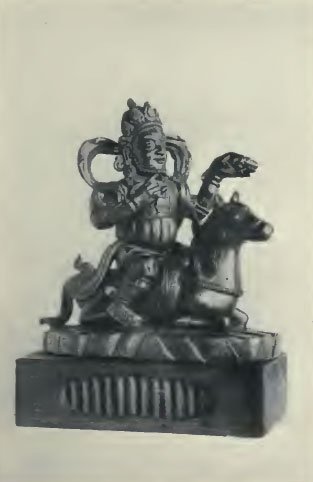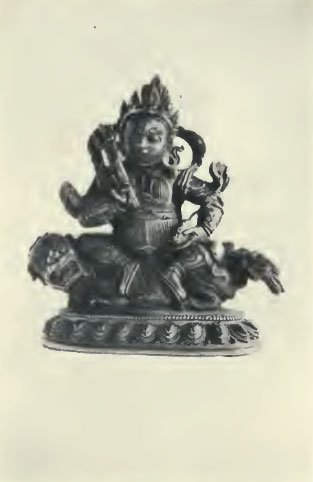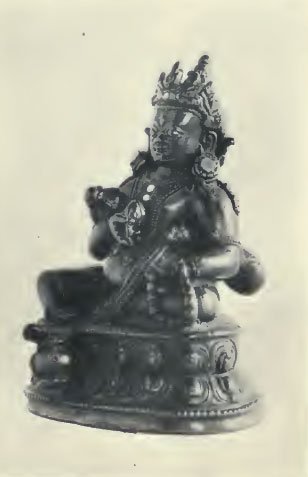The gods of northern Buddhism
their history, iconography and progressive evolution through the northern Buddhist countries
by Alice Getty | 1914 | 98,662 words
Indispensable reference for art historians, scholars of Eastern philosophy and religion. Wealth of detailed scholarly information on names, attributes, symbolism, pictorial representations of virtually every major and minor divinity in Mahayana pantheon, as worshipped in Nepal, Tibet, China, Korea, Mongolia, and Japan. 185 black-and-white illustrat...
The Dharmapala
(The Eight Terrible Ones). (T.) Drag-ched. [1]
(Drag-ched)
'he Eight Terrible Ones' (Defenders of the Law).
The Dharmapala, Defenders of Northern Buddhism, are Tantra divinities with the rank of Bodhisattva, and are supposed to wage war without mercy against the demons and all enemies of Buddhism.
The Drag-ched are worshipped singly or in a group of eight, called 'the Eight Terrible Ones', and are not malignant deities, as erroneously supposed, but are represented in ferocious form to inspire malignant spirits with fear.
Their worship was instituted in the beginning of the eighth century A. D. by Padmasambhava when he went to Tibet at the request of the Buddhist Tibetan king Detsan. He waged war against and conquered all the malignant gods in Tibet, only sparing those that promised to become Defenders of the Law (Dharmapala). Padmasambhava, in his turn, promised to enroll them in the Northern Buddhist Pantheon, and to see that they were properly worshipped.
The Dharmapala forms, which seem horrible and even disgusting to the uninitiated, are, to the devotee, however crudely expressed, the symbol of a religious thought. Even the yab-yum [2] attitude, which so offended the more refined taste of the Chinese and Japanese, is, according to M. Deniker, but 'an expression of divine ecstasy'. It symbolizes the Yoga system, or spiritual communion with the Most High.
The only goddess among the Dharmapala is Lha-mo, who is also one of the most terrifying manifestations in the group. The only god who is not represented as ferocious is Kuvera, god of Wealth, and one wonders at his presence among the 'Eight Terrible Ones', since he has no ferocious form. The explanation might possibly be found in the fact that in every group of ferocious deities there must be, following tradition, at least one pacific divinity; but against this hypothesis one must admit that in almost all the temple pictures of this group of eight Drag-ched a pacific deity, Buddha or Bodhisattva, is added.
The 'Eight Terrible Ones' are:
- Lha-mo.
- Ts'angs-pa.
- Beg-ts'e.
- Yama.
- Kuvera.
- Hayagriva.
- Mahakala.
- Yamantaka.
The lamas, however, sometimes make other combinations, putting one of the ferocious forms of Vajrapani in the place of one of the usual group; or some other Dharmapala manifestation of a Dhyani-Bodhisattva, taken for some special purpose, like Manjusri, who took the ferocious form of Yamantaka to conquer the god of Death, Yama.
In worshipping this group of eight Dharmapala the priests wear a special fiveleaved crown called chodpan, and special vestments.
The eight gods, with the exception of Kuvera and Ts'ahgs-pa, are represented with a crown of five skulls, above each of which is generally a flaming pearl, and the dishevelled hair stands on end in flame shape. There is the third eye, the brows are scowling, and the expression shows great anger. Around the neck is a long garland of heads. The lower body is covered by a tiger, elephant, or human skin. They tread on human beings, or animals, and, if painted, are red, dark blue, or black.
The most ferocious gods of the group are represented on a pinkish lotus with jagged petals, and, with the exception of Yama, Kuvera, and Ts'angs-pa, are almost invariably represented with their sakti
(T.) LHA-MO (Dharmapala)
'The goddess'.
(T.) dpal-ldan-lha-mo (the glorious goddess).
(S.) Kaladevi, sri-devi, or Srimatidevi
(M.) ukin tegri (lit. 'goddess-daughter').
Symbols: khadga (sword), beng (mace).
Colour: blue.
Vahana: horse (or mule).
Consort of Yama.
Lha-mo, the only feminine divinity among the 'Eight Terrible Ones', is one of the most terrifying manifestations in the Northern Buddhist Pantheon, and being the only goddess, Defender of the Mahay ana school, she was armed by the gods. Hevajra gave her two dice to determine the life of men, Brahma gave her a fan of peacock's feathers, and from Vishnu she received two luminous objects, of which she wears one in her head-dress, while the other hangs over her navel. Kuvera, the god of Wealth, gave her a lion, which she wears in her right ear; and Nanda, the serpent-god, gave her a serpent which hangs from her left ear. From Vajrapani she received a hammer. Other gods gave her a mule, whose covering is the skin of a Yaksha or demon, and the reins are of venomous serpents.
Lha-mo is represented seated sideways on her mule. She wears all the Dharmapala ornaments, and behind the skull crown her hair, in which there is a serpent and half-vajra, rises in flame shape, sometimes surmounted by a moon. She has the third eye, her expression is ferocious, and on either side of her head rise the stiff folds of a scarf like that worn by several of the Dharmapala. She wears a long garland of heads, and over her navel hangs a wheel-shaped ornament. Her covering is a tiger-skin. In her right upraised hand she brandishes the leng, or sceptre, sometimes surmounted by a skull, while the left holds the skull-cup at the breast. The back of the mule is covered by the skin of a demon, with the head hanging downwards. According to the legend given by Schlagintweit, [3] the skin is that of her son whom she killed, having made a vow that if she were unable to convert her people to Buddhism, she would kill her own son (PI. xlvi, fig. a).
The mule, if painted, is white, and has a disc between its ears; above the forelegs hang the dice given by Hevajra, and on its haunch is an eye, the legend of which is the following: In one of her incarnations, Lha-mo is believed to have been the wife of the king of the Yakshas in Ceylon.
The goddess had made a vow to convert her husband to Buddhism, or failing, to extirpate the royal race; and finding it not in her power to influence her husband, she
'flayed her son alive, drank his blood, and even ate his flesh'.
The king was so incensed, that he seized his bow and shot off an arrow after his fleeing wife. It pierced the haunch of her mule, and she pulled it out, pronouncing the following sentence:
'May the wound of my mule become an eye large enough to overlook the twenty-four regions, and may I myself extirpate the race of these malignant kings of Ceylon! '
The goddess then continued her journey northward through India to Tibet, Mongolia, and China, and is supposed to have settled in Eastern Siberia.
Lha-mo is accompanied by two acolytes: the dakini Makaravaktra (blue), who is either elephantor dolphin-headed and holds the bridle of the mule; and the dakini Simhavatra (red), with a lion's head, who follows her, holding a chopper and a skullcup. The group walks on a lake of blood, in which float skulls and human bones.
Although she is the consort of Yama, there is an example of Lha-mo in the embrace of Samvara with the elephant-skin over his shoulder, who is seated sideways on the mule (PI. XLVI, fig. b).
Lha-mo is sometimes surrounded by four ferocious goddesses, who are, according to Grlinwedel:
- Goddess of Spring (blue), seated on a yellow mule, holding a sword and a skull-cup.
- Goddess of Summer (red), on a blue yak, and holds a hatchet and skull.
- Goddess of Autumn (yellow), on a deer, and holds a knife and skull-cup, and around her neck are peacock plumes.
- Goddess of Winter (blue), on a camel. She carries a hammer and a skull-cup.
In Tibet, Lha-mo is looked upon as the Protectress of the Dalai-lama of Lha-sa and Tachi-Lumpo.
(T.) Tsángs-pa Dkar-po (Dharmapala)
'White Brahma'.
(M.) esrua (proper name).
(S.) Brahma.
(C.) Fan-wang.
Symbol: khadga (sword).
Vahana: white horse (or dragon).
Although Ts'angs-pa is one of the 'Eight Terrible Ones', but very little is known about him. He may be represented seated on a white horse, brandishing a sword, and sometimes carrying a banner. Like Beg-ts'e, he is a warrior god, but not so ferocious in aspect. Behind his crown is a turban, in which there may be a conch-shell, and he wears flowing garments and long sleeves. He sometimes accompanies one of the Five Great Kings, in which case he rides on a ram.
According to Pander, [4] Ts'angs-pa may be represented with four heads, like the Hindu form of Brahma, in which case he holds the Buddhist wheel at his breast with the right hand. The left seems to be in dblmya mudra.
(T.) Beg-ts'e [5] (Dharmapala)
(lit. 'hidden sheet of mail').
God of War and Protector of Horses.
(T.) Icam-srin (brother and sister), or Beg-ts'e (hidden shirt of mail).
(M.) egeci deguu (sister-brother).
Symbol: khadga (sword, with a shrimp-shaped handle).
Colour: red.
Little is known of the ferocious warrior-god, Beg-ts'e, who seems to be confounded by the Northern Buddhists with Hayagriva, whom some of the sects also call 'Protector of Horses'.
We hear of Beg-ts'e in a Mongolian legend [6] as appearing before the Dalai-lama, mKasgrub bDod-nams, at the head of an army of demons in the guise of different animals — horses, camels, rats, &c. The Dalai-lama had been summoned from Tibet by the powerful king, Altan Khan, to convert the Mongols to Buddhism, and when he found himself thus confronted he took, by his magic power, the form of the four-armed Avalokitesvara, with the two original arms at his breast in 'prayer' mudra. The footsteps of his horse left the marks of Avalokitesvara's mantra, 'Om, mani padme hum!' and Beg-ts'e, becoming convinced of his superior power and wisdom, was converted to Buddhism.
Beg-ts'e belongs to the group of the 'Eight Terrible Ones', and, as a warrior, wears a breastplate, while on his feet are Mongolian boots. His hair stands upright like flames of fire, he wears the skull crown, and has the third eye. His expression is ferocious. The right arm brandishes the sword — with a curious shrimp-shaped handle; the left hand holds a heart with the thumb and index, as if he were about to put it in his mouth — but this symbol may be missing. His left arm holds, against his body, a sword, bow, and flag. His lower limbs are covered by a tiger-skin, and he wears a long garland of heads. The god steps to the right on a prostrate horse, and his left foot treads on a human being. He may be accompanied by two small acolytes, a warrior seated on a wolf, and a nude figure of a woman seated on a lion. As Icam-srin means 'brother and sister', Grunwedel believes he may be so named on account of these two little figures.
Yama (Dharmapala)
or Dharmaraja.
God of Death.
(T.) cos-rgyal (king of the religion), or gsin-rje (lord of the dead).
(M.) erlik qan (king Erlik).
(C.) Yen-lo-wang (![]() ).
).
(J.) Emma-O.
Colour: dark blue, red or white (or yellow).
Symbols: dbyng-pa (sceptre), pasa (lasso), grigug (chopper).
Distinctive mark: wheel ornament on the breast.
Consort: Lhamo.
Attendant: his sister Yami.
Different forms: Phyi-sgrub, Snag-sgrub, Gsang-sgrub.
Yama is a Dharmapala (Drag-ched) with rank of Bodhisattva.
Yama, the Indian Pluto, was originally a king of Vaisall, who, when engaged in a bloody war, wished he were master of hell, and was accordingly reborn as Yama in hell, [7] together with his generals and army. His palace, made of copper and iron, was, according to the puranas, 'at the extremity of the earth, southward, and floating on the waters'. The wicked had 688,000 miles to travel, through terrifying ordeals, to reach it and receive their final punishment.
Yama, king and judge of the dead, is believed to sit in the centre of the regions of hell, which comprise eight hot and eight cold hells, as well as innumerable other places of punishment. The wicked are brought before him to be questioned and judged, and are then conducted to their punishment by demons.
Yama is generally accompanied by his sister Yarni, whose duty is to look after the female culprits. Although he is supreme ruler of hell, Yama nevertheless undergoes the same torments as the rest, in order to expiate his own sins, when he will be reborn as Samantaraja.
Pander, in his Pantheon des Tschangtscha Hutuktu, gives the following legend in regard to Yama: There was once a holy man who lived in a cave in deep meditation for fifty years, after which he was to enter into Nirvana. On the night of the fortyninth year, eleventh month, and twenty-ninth day, two robbers entered the cave with a stolen bull, which they proceeded to kill by cutting off its head. When they discovered the presence of the ascetic, they decided to do away with him as witness of their theft. He begged them to spare his life, explaining that in a few moments he would be entering into Nirvana, and that if they killed him before the time he would lose all the benefit of his fifty years' penance. But they refused to believe him, and cut of his head, whereupon his body assumed the ferocious form of Yama, King of Hell, and taking up the bull's head, he set it on his own headless shoulders.
He then killed the two robbers and drank their blood from cups made of their skulls. In his fury and insatiable thirst for victims he threatened to depopulate the whole of Tibet. The Tibetans appealed to their tutelary deity, Manjusri, to protect them from this formidable enemy, whereupon he assumed the ferocious form of Yamantaka and waged war against Yama. A fearful struggle ensued, in which Yamantaka (lit. 'he who conquers death') was victorious.
Yama has three forms, of which there are many variations: Phyi-sgrub, Snag-sgrub, and Gsang-sgrub. It is under this last form, Gsang-sgrub, that Yama was conquered by Yamantaka.
Gsang-sgrub. In this form he has a bull's head, third eye, and crown of skulls, behind which his hair rises in flame shape. He steps to the right on a bull, and holds a grigug (chopper) in his right hand and kapala (skull-cup) in his left. He may, however, hold a cintamani (magic jewel) in his right hand instead of the grigug, in which case he is looked upon as a 'God of Wealth'. He may also hold a mace and lasso (PL xlvii, fig. a). If painted, he is red. He is often accompanied by the Citipati or two skeletons dancing the Tsam dance (PI. lii, fig. b).
Phyi-sgrub, or minister of the exterior. He is represented with a bull's head, third eye, crown of skulls, hair rising in flame shape, and is naked, but has a belt of heads and many jewels. On his breast is an ornament representing the Buddhist wheel, his distinctive mark, for Tsoh-ka-pa, before his death, appointed Yama protector of the Yellow Bonnets (Ge-lug-pa sect) with great ceremony. He steps to the right on a bull, under which is a woman, and his attitude and expression show great excitement and fury. He is never represented with a sakti, but may be accompanied by his sister Yarni, in which case, if painted, Yama is dark blue and Yarn! pale blue. Yarn! stands at his left holding a skull-cup. If Yama is without his sister he is painted white or yellow.
Snag-sgnib, minister of the interior. In this form he is Judge of Hell. He is like the preceding, except that he steps to the left on a man — and his symbols are grigug and kapala. He is sometimes accompanied by two acolytes, each treading on a bull. If painted, his colour is dark blue.
Yama may be represented with a human face and with two of his six arms raised above his head in prayer mudra. On his breast is his distinctive mark, the wheel, and he may step directly on the lotus-throne (PI. xlvii, fig. b).
In China Yen-lo-wang (Yama) is not regent of the Buddhist hells, he is a subordinate under Ti-tsang (see) and the fifth of the ten Kings of Hell, who reign over ten courts of judgement. They are represented in Chinese temples, standing when in the presence of Ti-tsang, and surrounded by representations of the torments of the different hells.
Yen-lo-wang is believed to be assisted by his sister who judges the women, while he judges the men. They are called the Gam-ma-raja (![]() ) or the Royal Pair. He is referred to in the Ti-tsang sutra as
) or the Royal Pair. He is referred to in the Ti-tsang sutra as
'coming from the Iron Mountain, where the Buddhist hells are situated, to the Tau-li heaven (Trayastrimsa) to hear Sakya-muni Buddha deliver a sutra there'.
In Japan Emma-O (Yama) is regent and holds the same position as Yama in India. In both China and Japan the representations of Yama are practically alike, a middle-aged man with a fierce expression and a beard. On his head is a judge's cap, and he is dressed in flowing garments with the feet always covered. He is seated with the legs locked and in his right hand is the mace of office.
| PLATE XLVIII | ||
 |
 |
|
| a. Kuvera | b. Kuvera | |
 |
 |
|
| c. Kuvera | d. Kuvera | |
| Plate XLIX |
 |
| Dharmapala undetermined |
Footnotes and references:
[1]:
Table of J. Deniker.
[2]:
v. Vairocana and yab-yum; v. Glossary.
[3]:
Buddhism in Tibet, p. 112.
[4]:
Das Pantheon des Tschangfscha Hutuktu, No. 278.
[5]:
Lit. 'breastplate-covered'.
[6]:
Grunwedel, Mythologie du Bouddhisme, p. 82.
[7]:
Eitel, Handbook of Chinese Buddhism.
